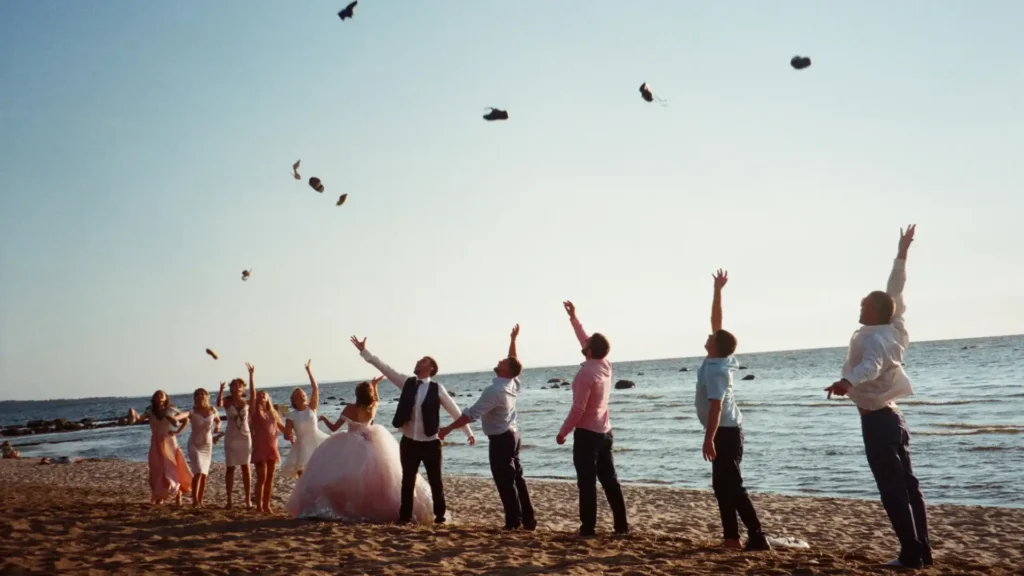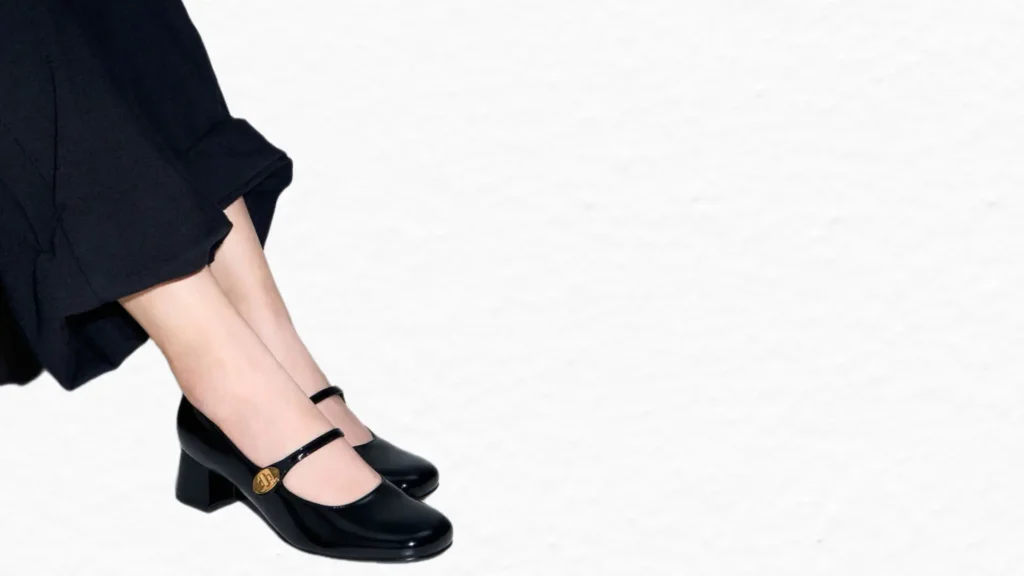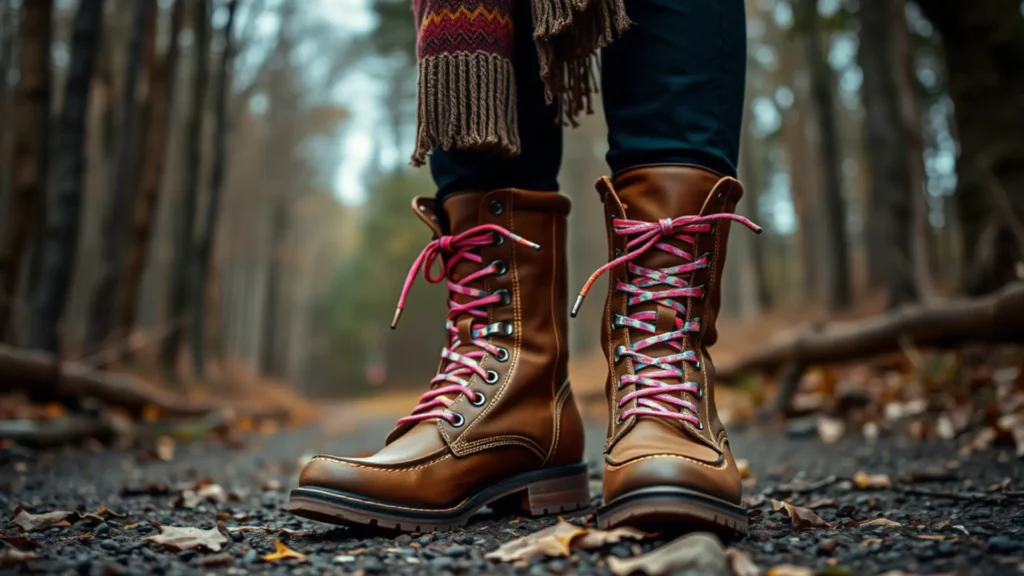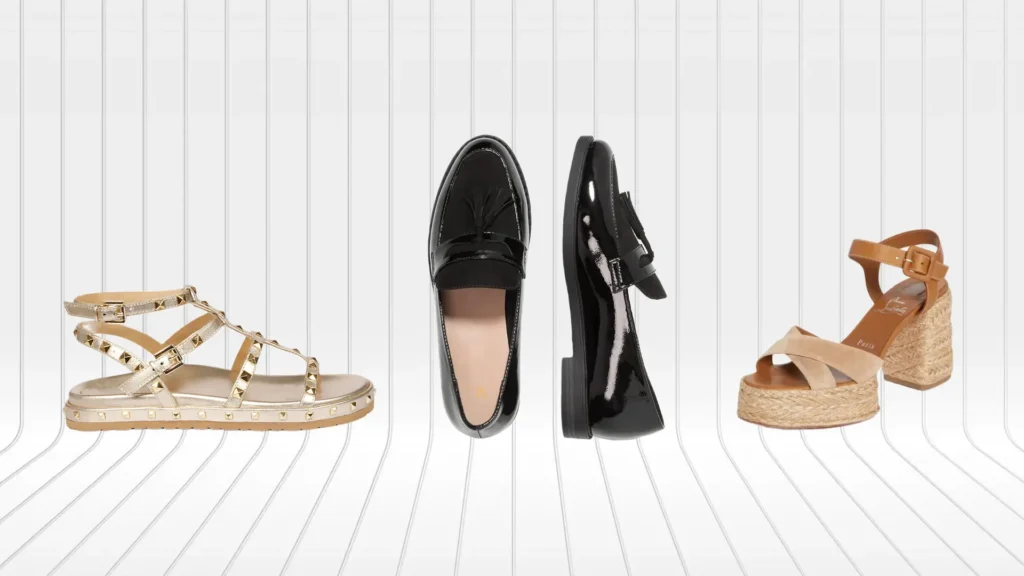A beach wedding is a dreamy event. The sand, ocean waves, and golden sunset create a romantic atmosphere. However, picking the right shoes for a beach wedding can be challenging. Sand is soft and shifts under your feet. Traditional heels sink. Casual flip-flops might not match the occasion. This guide will help you choose the perfect shoes for a beach wedding. It covers styles, materials, comfort, and practical tips for brides, grooms, bridesmaids, groomsmen, and guests.
Why Beach Wedding Shoes Are Unique
Beach weddings are different from indoor ceremonies. The ground is uneven and soft. Sand can be hot, wet, or sticky. Shoes need to handle these conditions while keeping you comfortable. They should also match the laid-back, romantic vibe of a beach setting.
Comfortable shoes are critical because you’ll walk, stand, and possibly dance on unstable terrain. Style is equally important. Your shoes should look good in photos and complement the wedding’s aesthetic. This guide breaks down the best options for everyone involved.
For the Bride: Elegant and Practical Choices
Brides want to look breathtaking on their wedding day. Shoes are a key part of the bridal look. They need to be beautiful, comfortable, and beach-friendly. Here are some tips to help brides choose the perfect pair.
Many brides choose to go barefoot. It’s romantic and practical. Walking barefoot on sand feels natural and prevents tripping. You won’t worry about shoes sinking. To add elegance, consider foot jewelry. Anklets with pearls, toe rings, and jeweled foot chains sparkle in the sunlight. Henna tattoos on the feet can also create a bohemian, beachy vibe. Barefoot looks are affordable and photogenic.
If barefoot isn’t for you, flat sandals are an excellent option. They’re comfortable and stylish. Look for sandals with thin, delicate straps. These feel bridal and pair well with flowy dresses. Choose sandals with embellishments like crystals, pearls, or lace for a special touch.
Avoid chunky or athletic sandals. They can clash with a wedding gown. Colors like white, ivory, gold, or blush work beautifully. Flat sandals are easy to walk in and won’t sink in the sand.
Some brides want the elegance of heels. Wedge heels are the best choice for a beach wedding. Unlike stilettos, wedges have a wider base. This provides stability on soft sand. Opt for low or medium-height wedges (2-3 inches).
Higher wedges can still sink or feel unsteady. Cork, raffia, or rope wedges have a beachy, natural look. They’re lightweight and complement airy dresses. Avoid heavy or metallic wedges—they can look too formal for the setting.
Stilettos are a poor choice for beach weddings. Their thin heels sink into the sand, making walking difficult. You risk tripping, twisting an ankle, or damaging your shoes. Stilettos also feel out of place in the relaxed beach environment. If you love heels, save stilettos for an indoor reception or a pre-wedding event. For the ceremony, stick to wedges, flats, or barefoot options.
Beach weddings are often warm and humid. Your feet need to stay cool. Choose shoes made of breathable materials like leather, satin, or mesh. These allow airflow and prevent sweating. Avoid plastic or synthetic materials—they trap heat and cause discomfort. Natural materials like raffia or cotton are also great for a beachy aesthetic. They’re durable and handle sand well.
Your shoes should complement your wedding dress. If your gown is simple, you can wear bold or sparkly shoes to add flair. If your dress is detailed with lace or beading, choose understated shoes to avoid clashing. Classic bridal colors like white, ivory, or champagne are safe choices. For a modern twist, try soft pastels like mint, lavender, or coral. These colors evoke the beach and look stunning in photos.
Always test your shoes on sand. Walk around to check for comfort and stability. Ensure they don’t slip off or rub your feet. Break them in a few weeks before the wedding to avoid blisters. If possible, visit the beach venue or a similar sandy area for a trial run. This helps you feel confident on the day of the ceremony.
Sand and saltwater can damage delicate shoes. Bring a backup pair in case your primary shoes get wet or uncomfortable. Simple flip-flops or inexpensive sandals work for walking to and from the ceremony. You can switch to your main shoes for photos and the reception.
For the Groom: Sharp and Beach-Appropriate Footwear
Grooms need shoes that are stylish, comfortable, and practical. Beach weddings call for a relaxed yet polished look. Here are some options for grooms.
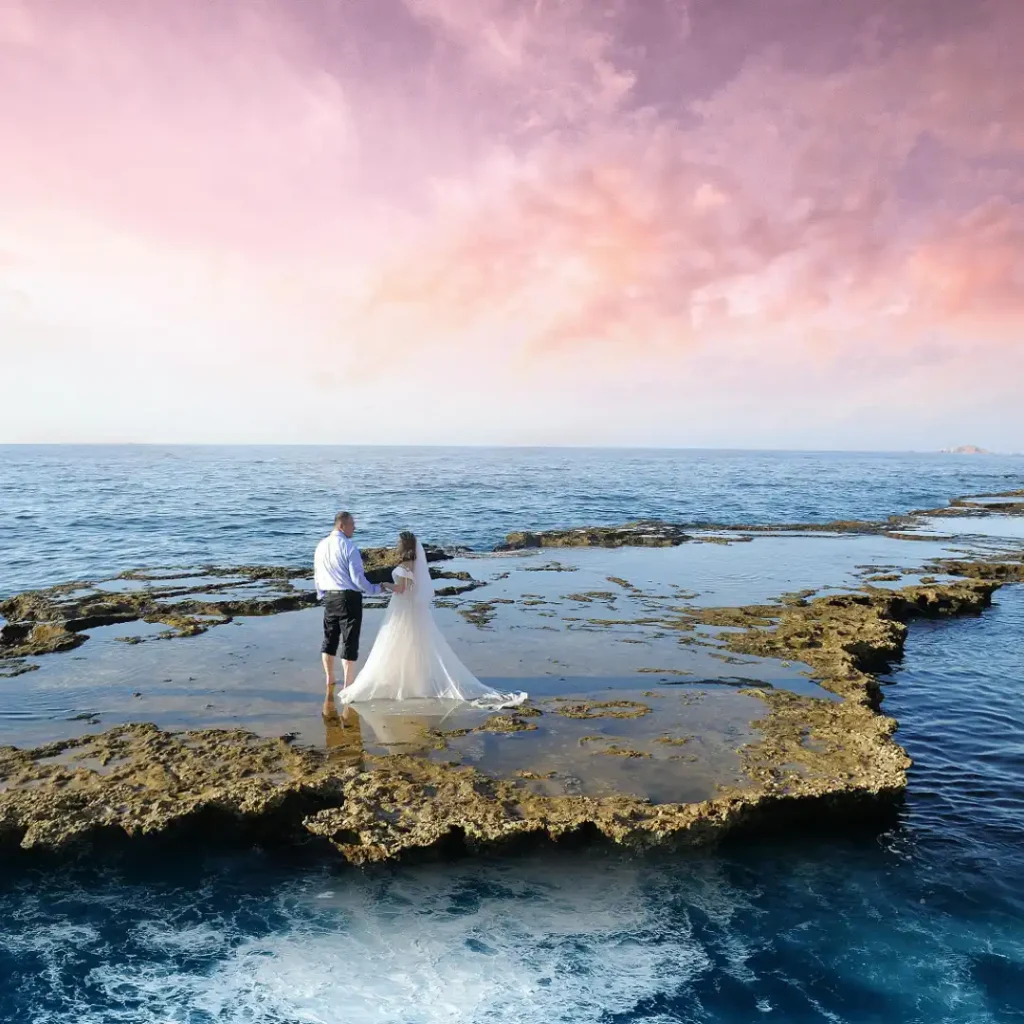
Loafers are a versatile choice. They’re dressy enough for a wedding but not as formal as oxfords. Choose loafers in leather or suede for a refined look. Neutral colors like tan, beige, or navy blend well with beach settings. Slip-on loafers without laces are easy to clean if sand gets inside. Look for loafers with non-slip soles for better traction on wet or sandy surfaces.
Boat shoes are a natural fit for beach weddings. They have a nautical, coastal feel that suits the environment. Opt for leather or canvas boat shoes in colors like navy, brown, or tan. Ensure they have rubber soles for grip. Boat shoes pair well with linen suits or lightweight blazers. They’re comfortable for standing and walking on sand.
For a laid-back wedding, grooms can wear sandals. Choose leather sandals with a sleek, minimalist design. Avoid flip-flops—they’re too informal for a wedding. Sandals with secure straps stay in place while walking. Tan, brown, or black sandals complement light-colored suits or khakis. They’re breathable and perfect for warm weather.
Socks are impractical at beach weddings. Sand can get trapped inside, causing discomfort. Most grooms go sockless for a relaxed, summery look. If you prefer coverage, try no-show socks. These are invisible but prevent rubbing or blisters. Make sure your shoes fit well without socks to avoid slipping.
Your shoes should coordinate with your attire. For a light linen suit or white shirt and khakis, tan loafers or sandals are ideal. For a darker suit or navy blazer, choose brown or navy shoes. Consider the wedding’s formality. A black-tie beach wedding might require polished loafers. A casual daytime wedding suits sandals or boat shoes.
Sand and saltwater can stain shoes. Brush off sand after the ceremony. Wipe leather shoes with a damp cloth and let them air dry. Avoid direct heat, as it can crack leather. Suede shoes may need a special brush to remove sand. Proper care ensures your shoes last beyond the wedding.
For Bridesmaids: Coordinating Style and Comfort
Bridesmaids need shoes that complement the wedding’s theme while keeping them comfortable. Here are some tips for bridesmaid footwear.
The bride may have a specific color or style in mind. Check with her before buying shoes. Some brides prefer matching shoes for all bridesmaids. Others allow flexibility within a color palette. Coordinate with the bridesmaid dresses to ensure a cohesive look.
Flat sandals are a safe choice. They’re comfortable and easy to walk in. Look for sandals with metallic details to match the wedding’s elegance. Low wedges (1-2 inches) are another option. They add slight height without sinking in the sand. Avoid high heels—they’re impractical and may not align with the beach vibe.
Neutral colors work with most dresses. They’re also reusable for other events. If the wedding has a color scheme, find shoes in a matching or complementary shade. Pastels or metallics often suit beach weddings.
Bridesmaids stand and walk a lot. Choose shoes with cushioned soles and good support. Avoid tight or narrow shoes that cause blisters. Break them in before the wedding to ensure a perfect fit.
For Groomsmen: Polished Yet Relaxed
Groomsmen should look sharp and coordinated. Their shoes need to handle the beach while matching the groom’s style.
Loafers are a great option. They’re polished but not overly formal. Tan or navy loafers work well with light suits. Boat shoes are another good choice. They’re casual and nautical, perfect for the beach. Choose leather or canvas in neutral colors.
For a relaxed wedding, leather sandals are acceptable. Pick sandals with a clean, structured design. Avoid sporty sandals—they’re too informal. Coordinate with the groom’s footwear for a unified look.
Like the groom, groomsmen should skip socks. No-show socks are an option for comfort. Ensure shoes fit well without socks to prevent slipping or rubbing.
For Guests: Stylish and Appropriate Choices
Guests want to look good without overshadowing the couple. Their shoes should be fashionable, comfortable, and beach-appropriate.
Female guests can wear flat sandals for ease and style. Metallic or beaded sandals add a dressy touch. Low wedges are another option—they provide height without sinking. Avoid high heels, chunky boots, or sneakers. These don’t suit the beach or a wedding’s elegance. Colors like gold, silver, or pastels complement summery dresses.
Male guests can choose loafers or boat shoes. Leather sandals are fine for casual weddings. Stick to neutral colors like tan, brown, or navy. Avoid formal dress shoes or athletic sneakers—they look out of place. Coordinate shoes with your outfit, such as chinos or a lightweight blazer.
The invitation will indicate the dress code. “Beach formal” calls for dressier shoes, like jeweled sandals or polished loafers. “Casual” or “beach chic” allows simpler sandals or canvas slip-ons. If unsure, ask the couple or wedding planner for guidance.
Sand can ruin shoes. Bring a second pair, like flip-flops or cheap sandals, for walking to and from the ceremony. Switch to nicer shoes for photos and the reception. This keeps your main pair clean and comfortable.
General Tips for Everyone
These tips apply to everyone attending a beach wedding.
You’ll be on your feet for hours. Prioritize shoes with cushioned soles and good arch support. Avoid tight or narrow shoes. Test them on sand to ensure they’re stable and comfortable.
Some beaches have boardwalks, mats, or wooden platforms for the ceremony. Others are entirely sand. Ask the couple about the setup. Solid surfaces allow slightly dressier shoes, like low heels or loafers. Pure sand calls for flats, sandals, or barefoot options.
Beach weather varies. It might be hot, windy, or rainy. Choose water-resistant materials like leather or canvas. Avoid suede—it stains easily. Check the forecast and bring an umbrella or shawl if needed.
Sand and saltwater can damage footwear. Brush off sand after the event. Wipe leather shoes with a damp cloth and air dry them. Use a suede brush for suede shoes. Proper care extends the life of your shoes.
Shoes aren’t the only way to stand out. Brides can wear ankle bracelets or henna tattoos. Grooms can add a colorful pocket square. Guests can accessorize with hats, scarves, or jewelry. These details enhance your look without relying on elaborate shoes.
Beach weddings often include dancing. Choose shoes you can move in. Flats and sandals are ideal for sandy dance floors. If the reception is indoors, consider bringing heels or dress shoes to change into.
Beach weddings are relaxed and romantic. Your shoes should reflect this. Avoid overly formal or heavy footwear. Embrace light, airy styles that evoke the ocean and sand.
Choosing shoes for a beach wedding is about finding the right balance. You want footwear that’s stylish and practical for sand and surf. Always test your shoes on sand. Check the weather and venue setup. Bring a backup pair for peace of mind.

